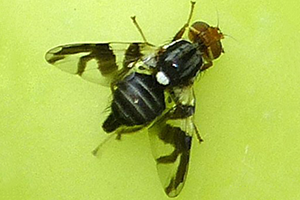Photo Credit: © Stuart Tingley via iNaturalist.org. Creative Commons Attribution-NonCommercial 4.0 International (CC BY-NC 4.0) License; https://creativecommons.org/licenses/by-nc/4.0/.
Rhagoletis pomonella
Common Name: apple maggot
Animal Guild: Insect
Class > Order > Family: Insecta > Diptera > Tephritidae
